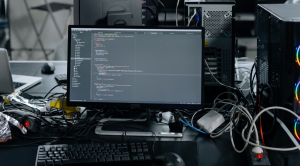How to identify and remove app monitors on your device
Few types of malware can penetrate as deeply as stalkerware. If someone installs it on your phone, they can not only track your location but also see everything you type into your device. Learn how these apps work and what steps to take if you suspect you're being tracked with one of them.
What is tracking software?
Stalkerware is a form of commercial spyware that allows tracking of other people, especially those with a personal relationship to you, such as an employee, spouse or lover.
Tracking software use is on the rise: In 2021, cybersecurity service Malwarebytes revealed that tracking software detections reached an all-time high for smartphones, with 54,677 warnings are reported. Tracking software applications often affect phones because people carry their smartphones everywhere. The amount of data collected from a smartphone is often much more valuable than data from a PC or laptop.
The main difference between tracking software and spyware is that tracking software is typically used by individuals while spyware is used by governments and law enforcement agencies.
Stalkerware is not only unethical but also scary. In this article, we will explain the different types of stalkerware, how they work, and how to protect yourself from such apps.
3 types of tracking apps and their general functions
Location tracking application
An app can track GPS coordinates or determine your location based on the Wi-Fi network you're connected to. Location data can reveal a lot about a person and their daily habits.
Contact tracking application
This type of tracking software is designed to record phone calls and record every keystroke in the texts and emails you send.
Applications that steal files and private data
These apps monitor any changes on your device and transmit data to a server that a stalker can access. This is a serious invasion of privacy and is especially dangerous if the victim has sensitive photos, videos, or other records that could be abused.
Two of the most popular tracking apps, Cerberus and Reptillicus, operate in stealth mode. They allow users to read messages from third-party messaging apps like WhatsApp and Telegram, text messages, and view photos and videos in the media library. Some tracking apps also allow users to track calendar events, take screenshots, access contact lists, and even take photos with the front camera.
How is tracking software installed?
To install stalkerware on your phone, the stalker most likely has to do this directly on your device. Therefore, you should not leave your phone unattended and unlocked, nor should you lend it to anyone, especially those who have reason to spy on you. Note that because apps on the iPhone must be downloaded from the App Store, it is more difficult to install malware onto the iPhone.
A stalker can take your phone and install stalkerware apps from the App Store or Play Store, although these apps are often described innocuously as "family trackers." Stalkerware can also be installed through connecting the phone to the attacker's computer with a cable. Both of these methods require the attacker to have direct physical access to your phone.
Additionally, a stalker could install software on your phone through a link or trick you into installing software on your device through a fake link.
What should I do if there is tracking software on my phone?
Put your safety first. Stalkerware can be a sign of an abusive or compromising relationship. If you are concerned about your physical safety, contact a domestic violence hotline or organization for support and guidance.
Identify and remove tracking software First, scan your phone for malware by downloading a trusted mobile security app or antivirus software like Malwarebytes or Bitdefender Mobile Security.
Next, double check the permissions granted to the apps on your phone in the settings. Look for apps that have excessive access to your location, microphone, camera, or call logs that you don't recognize or have allowed. Uninstall any suspect applications immediately.
Change your password Finally, change your password. Reset passwords for all your online accounts, especially those accessed from your phone. Use strong, unique passwords for each account, and consider enabling two-factor authentication for added security.
How to protect yourself from tracking software
Changing all passwords and enabling multi-factor authentication on your trusted devices is important to protect personal information. Avoid rooting or jailbreaking your device as this removes operating system limitations, allows installation of third-party applications, and bypasses built-in security measures. Stalkerware often takes advantage of these to conduct attacks. On iPhones, installing stalkerware usually requires jailbreaking. Rooted or jailbroken devices are more vulnerable to viruses, malware, and stalkerware.
Always monitor your smartphone and other devices. Periodically check the applications on your phone and remove unnecessary applications to minimize the risk of being attacked. Make sure your operating system and applications are kept up to date to protect against known security vulnerabilities.
Finally, if necessary, back up your data and factory reset your device to start over. Remember that you should only reinstall essential apps after a fresh install or factory reset of your device's operating system. This will help ensure that only safe and necessary applications are installed on your device.










